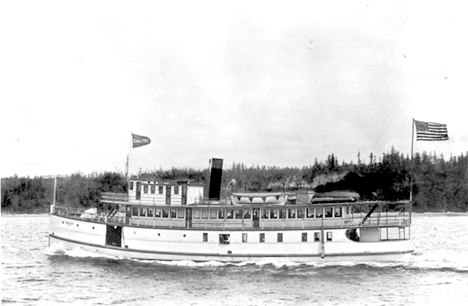Living on an island, it’s good to know there is a boat available for escape.
On the South End of Whidbey Island, the ferries are the main connection between residents and the mainland, a valuable feature which was accentuated by the recent loss of the car ferry fleet on the Keystone-Port Townsend route last November.
Retired farmer and author Roger Sherman will talk about the significance of maritime transportation along the South Whidbey coast at the South Whidbey Historical Society’s “Then and Now” program at 7 p.m. Thursday, Jan. 24 in the Fireside Room at Trinity Lutheran Church in Freeland.
Sherman’s slide show presentation “Whidbey Island Maritime History” takes a broad view of maritime transportation, connecting its history to modern-day systems.
It starts at the beginning with the fur traders and the explorers and continues through the decades of the docks, steam boats, boat building, fishing resorts, light houses, fish traps, water festivals and ferries, culminating with the Keystone Ferry fiasco.
Sherman, a longtime islander, is the author of “The Sinking of the Calista” and knows a lion’s share of knowledge about the mosquito fleet that serviced Whidbey Island in the early part of the 20th century.
“I developed my maritime interests as a 25-year volunteer with the Boy Scouts of America Sea Scout program,” Sherman said.
“After retiring from scouting, I started looking into our island maritime heritage.”
Five members of his father’s family were traveling to Seattle aboard the ferry Calista on July 27, 1922.
The family connection to the sinking of the Calista piqued his interest and with further investigation, Sherman discovered that there was not very much documentation surrounding any of the history of maritime travel.
He set about to change that.
Sherman said the Calista was similar to most of the mosquito fleet on Puget Sound. It carried both freight and passengers in the years between 1911 to 1922.
On that July day the Calista was rammed by a Japanese freighter off West Point near Seattle and sank 28 minutes later. Luckily there was no loss of life. Included among the 75 passengers and crew on board was Margaret McLeod, the mayor of Langley at the time.
The following excerpt is what Margaret wrote about the sinking:
“While I did get my feet wet, that was about the extent of the damage. The collision occurred so quickly that I cannot say how it happened. All I recall is that Purser McGinnis and Captain Lovejoy shouted to us to get on deck as fast as possible, and we did. I guess I was the last passenger off the Calista.
“I am somewhat heavy and not very active, and the others were in the boats before I got there. Captain Lovejoy made them hold the boat for me and I got into it all right.
“There was no excitement and everybody, especially the Calista’s crew, seemed to know just what to do. Just about the time the Calista sank, the tug Forest T. Crosby came alongside of us and I got aboard the tug. They wanted me to climb up the ladder to the Hawaii Maru, but
I was well satisfied with the climbing I had done already and told them I would stay on the tug.”
Sherman said many of the ferries of Puget Sound have enjoyed minor celebrity status among their passengers over the years.
The most famous ferry was the Kalakala. It never ran the Whidbey Island route, but Sherman has pictures of the vessel as part of his presentation and said the Kalakala is certainly worth talking about.
In fact, he said all the ferries had their particular individualities.
The Kulshan, for example, ran the Columbia Beach-Mukilteo route for many years.
“The kids called it ‘the submarine’ and hated it because of the open car deck and limited snack facilities,” Sherman said.
Sherman is at work on his second book on the subject of the maritime history of the Puget Sound and hopes to enlighten islanders with his presentation to the state of the ferry system both then and now.
The South Whidbey Historical Society sponsored program is open to the public. A $2 donation is requested.
Patricia Duff can be reached at 221-5300 or pduff@southwhidbeyrecord.com.



